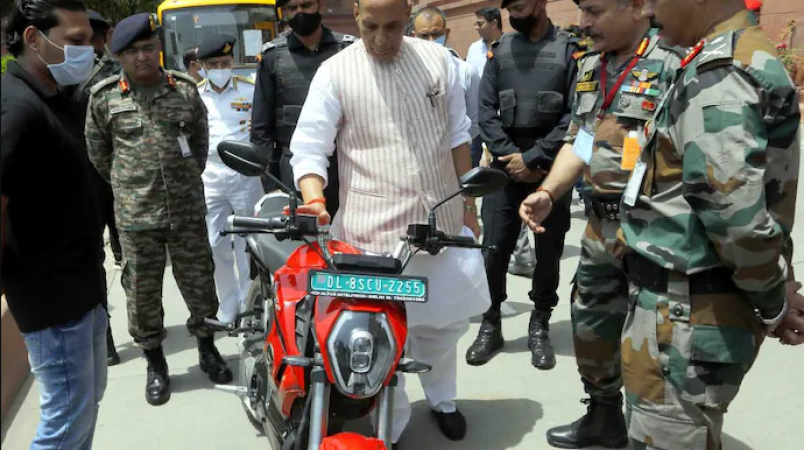
New Delhi: A roadmap for the introduction of electric vehicles (EVs) is being developed by the Indian Army in an effort to reduce its dependence on fossil fuels.
Currently, EVs are planned to be used for non-combat operations in non-conflict areas in three categories: cars, buses and motorcycles.
The Army, along with the Air Force, Navy and paramilitary forces, use a wide range of fossil fuel-powered vehicles in different terrains and climates.
Also Read: Moto Morini motorcycles are now available in India
Light vehicles will transition to EVs at about 25%, buses at 38% and motorcycles at 48%. The Army has opened tenders for the purchase of 60 electric buses and 24 fast chargers, apart from setting up EV charging stations in its cantonment areas.
The 19 EVs were put into service by the Indian Navy's Western Naval Command in September last year in residential areas at Navy Nagar in South Mumbai. A spokesman said at the time that "this is the first time for the Navy to be involved on such a large scale."
The initiative is in line with the Centre's National Clean Air Program from 2019, which aims to reduce air particulate concentrations by 20-30% in 2024.
Due to their low noise and thermal signature, EVs are probably best known to top military officers for their advantages in combat roles.
They will probably go into service with unmanned ground vehicles in the near future. To ensure that these vehicles can communicate with each other in combat zones, armed forces and paramilitary organizations should adopt a single standard for their EV charging infrastructure.
Also Read: Ultra-luxury feature-packed and bulletproof 2023 Rezvani vengeance SUV is a beast
Extraordinary buy-in
In April, senior officers and the then Army Chief, General MM Naravane, had attended an EV demonstration apart from Defense Minister Rajnath Singh. The event saw Tata Motors, Perfect Metal Industries and Revolt Motors showcase their electric vehicles and provide attendees with updates on the latest advancements in technology and range.
According to General Naravane, the Army believed that Electric Vehicles (EVs) were the way of the future and wanted to be a pioneer in implementing this technology. The recommendations were carried out by a board of officers, with Lieutenant General Manoj Kumar Singh Yadav, Director General Supplies and Transport, serving as its chairman.
The Army Chief was informed about the EV plans during a meeting of Army Commanders in April. This board was set up to lay down a clear, time bound roadmap for EV adoption in the Armed Forces.
Also Read: EV hub thanks to Honda's $700 million investment in retooling three Ohio plants
In August 2019, the Army had already deployed electric vehicles for its officers in New Delhi. Energy Efficiency Services, a joint venture of Central Public Sector Organizations under the Ministry of Power, was a participant. The then Quartermaster General Lt Gen Gopal R signaled the commencement of the first batch.
In this pilot project, the Army intended to operate the first batch of 10 Mahindra e-Veritos before increasing the strength of its officers in New Delhi. As EV use grows, the military will need to invest heavily in the infrastructure needed for charging.
The major impetus from the policies of the Center for Faster Adoption and Manufacturing (FAME I and II) of (Hybrid and) Electric Vehicles in India will also be beneficial for the Armed Forces.
More significantly, Army's demand for EVs will increase the order book for automakers, especially Tata Motors, which has developed a strong portfolio with electric models such as Nexon, Tigor and Tiago.
Tata Motors has sold over 40,000 EVs since entering the personal EV market in 2020, with Nexon accounting for over 30,000 sales, making it a market share of 63% in the most recent financial year. has become a leader.
A Nexon EV Max climbed the Umling La pass in Ladakh in September, which is 19,024 feet above sea level, making it the highest motorable road in the world. It was the first electric vehicle at such a height.
Since 1958, Tata Motors Defense has provided over 150,000 vehicles to the Indian Army and Paramilitary Forces, forming a strong bond with the Armed Forces. More than 1,500 units of the Tata Safari Storme 4X4 have been delivered since it was selected as the Army's General Service 800 (GS800) vehicle to replace the Maruti Gypsy 4X4.
Army also placed a purchase order with Tata Motors Defense for 3192 Safari Storme 4X4s. The locally developed Safari Storme GS800 diesel SUV has a minimum payload capacity of 800 kg and is a modern, highly reliable and tough vehicle.
Compared to the Maruti Gypsy 4X4 from the 1980s, it has six passenger seats, 60% more payload, 70% more power and 200% more torque.
Also Read: Renault is looking for a new partner for create new vehicles with internal combustion engines
Tata Motors has been modified to withstand extremely difficult operational conditions, including high-altitude drives and traversing snow-covered regions, crossing deserts to marshy lands.
These extensive tests were conducted with the army for 15 months in a variety of terrain. With recovery hooks, a jerry can, and fog lamps, the Tata GS800 Safari Storme 4X4 was specially modified for the army.